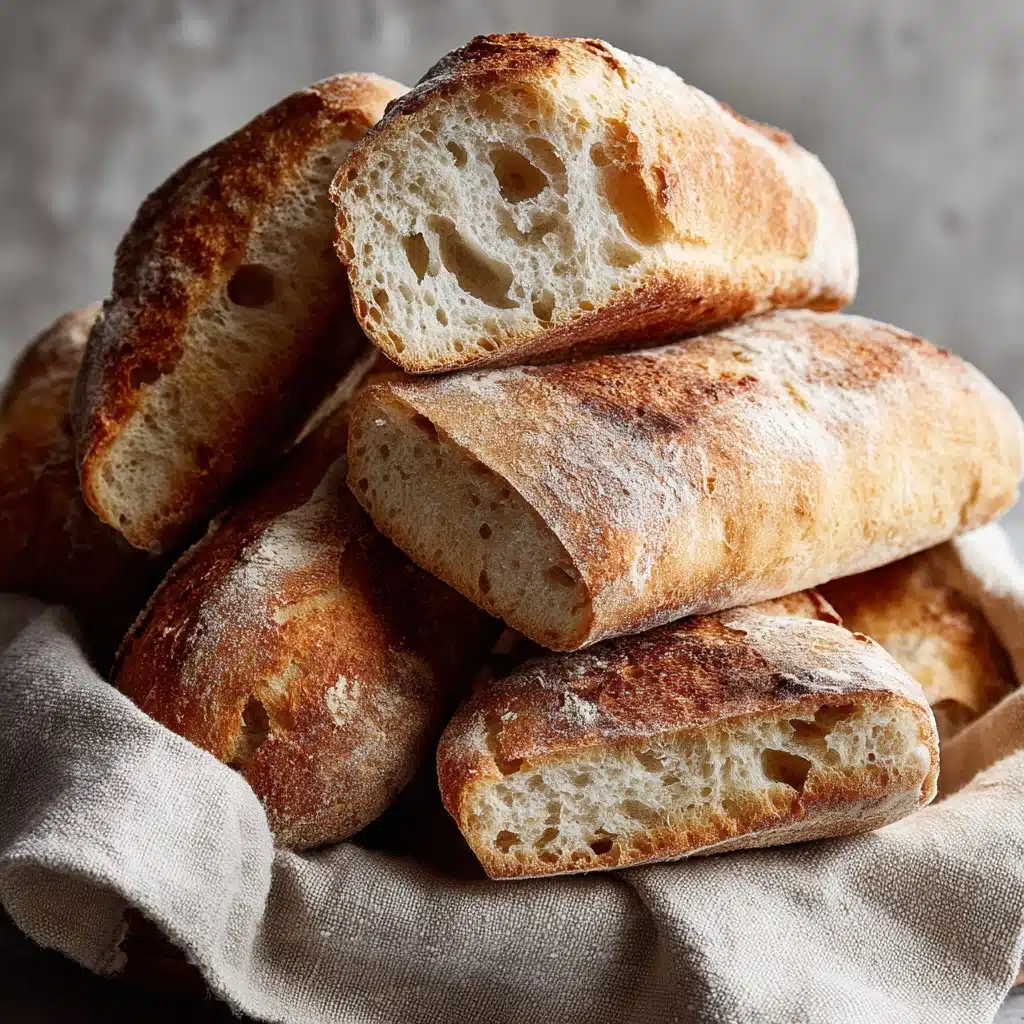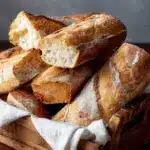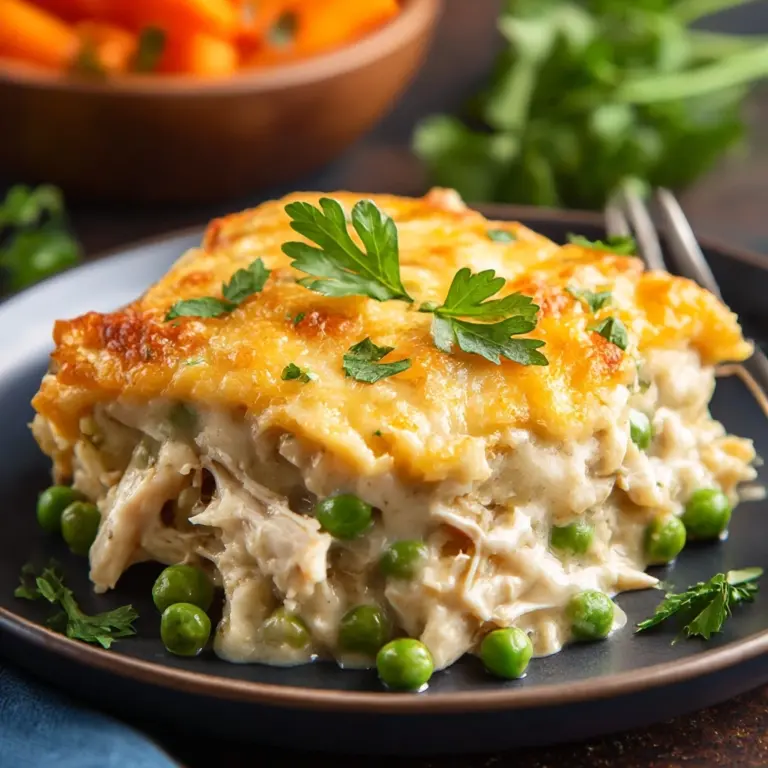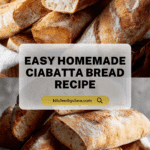Ciabatta Bread Recipe
Are you ready to fill your kitchen with the irresistible aroma of fresh, crusty bread? My Ciabatta Bread recipe is an absolute must for anyone who loves the satisfaction of baking homemade bread with a dynamic, bubbly crumb and a delightfully crisp crust. This iconic Italian loaf is surprisingly simple to pull together, and in just a few steps, you’ll have pillowy bread that’s perfect for dipping, stacking, or savoring on its own. Get ready to make this Ciabatta Bread a regular star at your table!

Ingredients You’ll Need
The magic of Ciabatta Bread truly comes from its simplicity. Each ingredient has a crucial role, from building flavor to helping achieve that signature chewy, airy texture. Let’s look at what you’ll need and why it matters.
- All-purpose flour: Provides structure and a delicate crumb, giving Ciabatta its signature open holes.
- Warm water (110°F): Activates the yeast for a great rise and keeps the dough wonderfully moist and airy.
- Active dry yeast: The secret to delightful bubbles and a light, flavorful loaf.
- Salt: Boosts flavor and helps control the fermentation for balanced bread.
- Olive oil: Adds richness, extra tenderness, and a touch of golden color to the crust.
How to Make Ciabatta Bread
Step 1: Mix the Dough
Start by grabbing your biggest bowl and stirring together the flour and yeast. Once blended, slowly pour in the warm water, stirring all the while. Don’t rush this step—the water will help the mixture come together to form a shaggy, sticky dough. This is the foundation of amazing Ciabatta Bread, so mix until everything is just combined.
Step 2: Knead to Perfection
Turn the dough out onto a lightly floured surface. Set a timer for 10 minutes, then stretch, fold, and knead with gusto! Ciabatta dough is loose and soft, but kneading develops the gluten that delivers that classic chew and those sought-after big air pockets. Once it’s smooth and elastic, you’re ready for the next step.
Step 3: First Rise
Rub a generous swirl of olive oil in a clean bowl and plop your dough inside, turning once so it’s lightly coated. Cover the bowl with a damp cloth and let it rest in a cozy, draft-free spot for about 2 hours. You’ll watch your dough puff up and double in size—this is when the Ciabatta Bread’s rustic texture really begins to develop!
Step 4: Shape the Loaves
Gently punch down the dough to deflate some of the air, then carefully turn it onto a floured board. Divide it into two equals, and shape each into that classic, slightly flat rectangle loaf. Try not to over-handle the dough—you want those air bubbles to stay intact!
Step 5: Second Rise
Place your shaped loaves on parchment-lined baking sheets. Cover them loosely (a kitchen towel works perfectly) and let rise for about an hour. They’ll expand a bit more, promising plenty of airy holes in your finished Ciabatta Bread.
Step 6: Bake Until Golden
Preheat your oven to 450°F (230°C). Drizzle each loaf with a little olive oil and, if you like, a sprinkle of flaky sea salt. Slide the loaves into the hot oven and let them bake for 25 to 30 minutes, until they’re gloriously golden and sound hollow when tapped. Cool on a rack just long enough to resist burning your fingers—if you can wait that long!
How to Serve Ciabatta Bread

Garnishes
Don’t be shy with garnishes! A drizzle of peppery olive oil and a sprinkle of flaky sea salt make this Ciabatta Bread sparkle. For a touch of color, try fresh torn basil or even a flurry of grated parmesan warm from the oven. Each addition brings out more character in every slice.
Side Dishes
Ciabatta Bread is the ultimate companion for hearty soups, vibrant salads, and robust Italian mains. It’s sensational alongside classic tomato soup, a rustic stew, or even just a plate of fresh mozzarella and tomatoes. The bread’s airy pockets are perfect for picking up broths, sauces, and dressings galore.
Creative Ways to Present
If you want to step up your game, turn this Ciabatta Bread into open-face bruschetta, pressed panini, or playful crostini topped with whipped ricotta and honey. You can even cube and toast it for unforgettable homemade croutons or use oversized slices as the base for personal flatbread pizzas. The possibilities are endless!
Make Ahead and Storage
Storing Leftovers
Wrap leftover Ciabatta Bread in a clean kitchen towel, or slip it into a paper bag to help preserve its crisp crust for up to two days at room temperature. Avoid airtight plastic since it can soften the crust, but if the bread begins to dry out, a light mist of water before reheating works wonders.
Freezing
This bread freezes like a dream! Simply wait until it’s completely cooled, then wrap each loaf tightly in plastic wrap and a layer of foil. Pop it into the freezer and enjoy it for up to three months. Thaw at room temperature and it’ll taste like the day you baked it.
Reheating
To revive the magic, preheat your oven to 350°F, splash the loaf lightly with water, and bake it for about 10 minutes. The crust will crisp up, and the inside will be warm and fluffy again—just like fresh Ciabatta Bread should be!
FAQs
Why is my Ciabatta Bread dough so sticky?
A sticky dough is a sign you’re on the right track! Ciabatta dough is wetter than typical bread dough, which is what creates its signature airy, chewy interior. Resist the urge to add too much flour when kneading; just flour your hands and surface as needed.
Can I use bread flour instead of all-purpose flour?
Absolutely! Bread flour contains more protein, which can give you even bigger holes and more chew in your Ciabatta Bread. The result is a little sturdier but equally delicious.
Do I need a mixer for this recipe?
No mixer needed! While a stand mixer makes the kneading a bit easier, this Ciabatta Bread dough can be made entirely by hand. A good old-fashioned knead on the countertop will get your gluten working perfectly.
My bread didn’t rise much. What happened?
Check that your yeast is fresh and the water isn’t too hot, which can kill the yeast. Also, be patient with proofing time—cool rooms may take a little longer for the dough to double in size.
How do I get a crispier crust?
If you crave an extra-crunchy crust, try baking the bread with a pan of water on the bottom rack of your oven to create steam. This mimics bakery-style baking and works wonders for Ciabatta Bread.
Final Thoughts
I promise, there’s nothing quite like the moment you tear into a warm loaf of homemade Ciabatta Bread. The crackle of the crust, those glorious holes, and the fresh aroma will have everyone reaching for a second slice. Give this recipe a try—you’ll be amazed at what you can bake with just a few pantry staples and a bit of love!
PrintCiabatta Bread Recipe
Learn how to make delicious Ciabatta Bread at home with this easy recipe. This rustic Italian bread has a crisp crust and a chewy crumb, perfect for sandwiches or dipping in olive oil.
- Prep Time: 20 minutes
- Cook Time: 30 minutes
- Total Time: 3 hours
- Yield: 2 loaves 1x
- Category: Bread
- Method: Baking
- Cuisine: Italian
- Diet: Vegetarian
Ingredients
Dough:
- 4 cups all-purpose flour
- 1½ cups warm water (110°F)
- 2¼ teaspoons active dry yeast
- 2 teaspoons salt
- 2 tablespoons olive oil
Instructions
- Mix the Dough: In a large bowl, combine flour and yeast. Gradually add warm water, stirring until a shaggy dough forms.
- Knead the Dough: On a floured surface, knead the dough for about 10 minutes until smooth and elastic.
- Rise the Dough: Place the dough in an oiled bowl, cover with a damp cloth, and let it rise in a warm place for about 2 hours or until doubled in size.
- Shape the Loaves: Gently punch down the dough, divide it into two pieces, and shape each into rectangular loaves.
- Final Rise and Bake: Transfer the loaves to parchment-lined baking sheets, cover, and let rise for another hour. Preheat the oven to 450°F (230°C). Drizzle the loaves with olive oil, sprinkle sea salt, and bake for 25-30 minutes until golden brown.
Nutrition
- Serving Size: 1 slice (about 50g)
- Calories: 160
- Sugar: 0.5g
- Sodium: 200mg
- Fat: 2g
- Saturated Fat: 0.3g
- Unsaturated Fat: 1.5g
- Trans Fat: 0g
- Carbohydrates: 30g
- Fiber: 1g
- Protein: 5g
- Cholesterol: 0mg
Keywords: Ciabatta Bread, Italian Bread Recipe, Homemade Bread, Rustic Bread, Bread Baking








